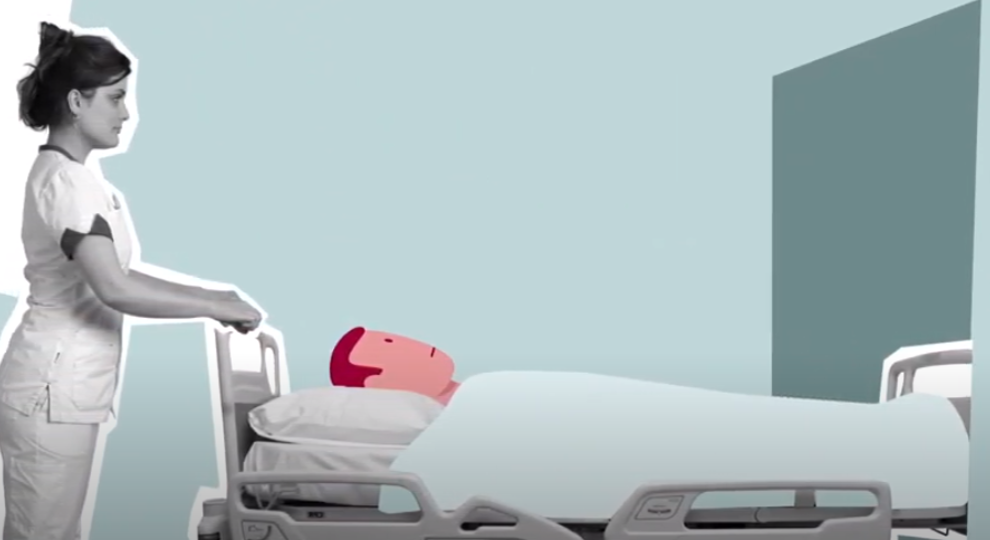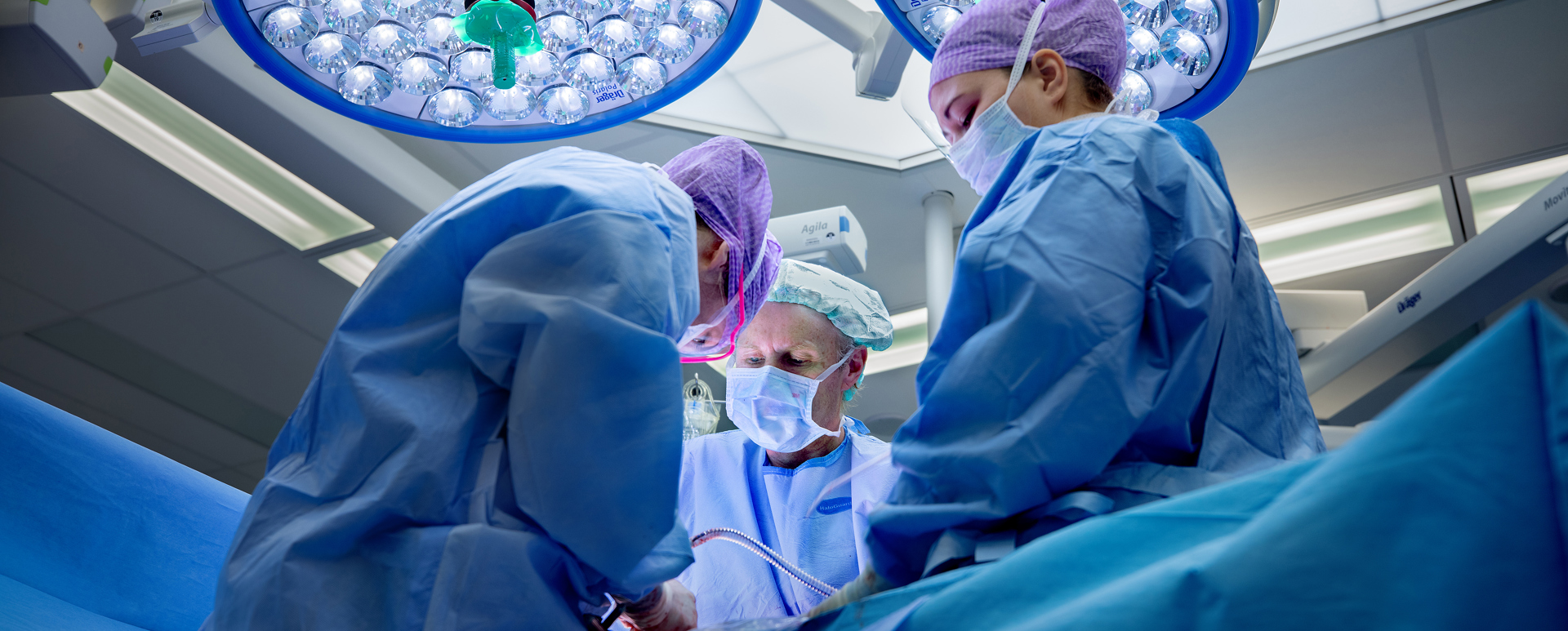Surgery for sarcomas
Sarcomas are malignant soft tissue tumors. These tumors usually do not cause symptoms until they have had a chance to grow and develop. There are over 50 types of sarcomas that range in terms of aggression. The treatment you will receive will depend on the type.
The goal of the treatment is to surgically remove the tumor in its entirety. We often remove healthy-looking tissue around the margins of the tumor together with the cancer. Many sarcoma types also require radiation therapy, usually before your surgery. This will help us keep the risk of recurrence as low as possible. Certain sarcoma types are sensitive to chemotherapy, which will diminish the risk of metastases and improve the success rate of the treatment.
More information
Surgery for sarcomas - what to expect?
The surgery aims to remove the tumor while sparing the rest of the body and its function as best as possible.
Your surgeon will remove as much of the tissue as possible. If the tumor has grown into the biopsy channel and vital structures like muscles, blood vessels, and nerves, these will need to be removed as well. If the tumor merely presses against these structures but has not compromised them further, we will try to spare them, as long as this is medically responsible.
Certain types of tumors, such as the DermatoFibroSarcoma Protuberans, can be surgically removed without prior treatment with radiation therapy. These tumor types require a very wide margin with multiple centimeters of tissue being removed along with the tumor as a safety precaution. You will be under general anesthesia during this procedure. One of the surgeons involved in this procedure is a plastic surgeon who will close the remaining wound by covering it with skin, or skin and muscle from elsewhere in the body.
Even (and especially) if your surgery is preceded by radiation therapy, and the tumor removal left a large wound, a plastic surgeon can close the wound by covering it with healthy muscle tissue from elsewhere in the body, that has not been treated with radiation therapy.
Sarcomas of the abdomen often require removal of the affected (or surrounding) organ(s). A large liposarcoma, a tumor of the fatty tissue, that developed in the back of the abdominal cavity may require the removal of a kidney and a part of the large intestine. Certain tumors may necessitate the removal and replacement of an important section of the large blood vessels in the back of the abdomen.
Effectiveness
Your prognosis and treatment depends on the type of sarcoma you have. With the best localized treatment possible, survival rate for people with sarcomas is about 80%. The exact rate will depend on the place, stage, and aggressive characteristics of the tumor. The risk of metastases also depends on the type and aggressiveness of the tumor and can vary between 5 and 50%.
A successful first treatment can decrease the risk of recurrence. When sarcomas grow back in the exact same location, the risk of metastases will be much higher, which will affect your prognosis.
Preoperative screening
Before your surgery, you will be invited to meet with your anesthesiologist at the outpatient clinic for a consultation and a brief examination to assess your overall shape and any potential particularities we will need to keep in mind. The consultation assistant will measure your heart rate and blood pressure and will inquire about your height and weight. If needed, we can take those measurements during the appointment.
This preoperative screening will take approximately 20 minutes and will form the base of your anesthesia. Your anesthesiologist will listen to your lungs and heart and inspect your mouth and throat in preparation of the breathing tube that will be placed during surgery. Your anesthesiologist will also ask you:
Before your surgery, you will be invited to meet with your anesthesiologist at the outpatient clinic for a consultation and a brief examination to assess your overall shape and any potential particularities we will need to keep in mind. The consultation assistant will measure your heart rate and blood pressure and will inquire about your height and weight. If needed, we can take those measurements during the appointment.
This preoperative screening will take approximately 20 minutes and will form the base of your anesthesia. Your anesthesiologist will listen to your lungs and heart and inspect your mouth and throat in preparation of the breathing tube that will be placed during surgery. Your anesthesiologist will also ask you:
- whether you have been under anesthesia before
- whether you have any other conditions
- whether you have taken cancer medicine before
- whether you have had radiation treatment before
- whether you have any allergies
- whether you smoke
- whether you drink alcohol
- what kind of medication you take
Please inform your anesthesiologist of the type of medication and dose you take, and how often you take it. Your physician may want to run more tests before your surgery, such as: electrocardiogram (ECG), lung x-rays, a lung function test, or a blood test.
General or local anesthesia
Before your surgery you will be given general anesthesia, local anesthesia, or a combination of the two. General anesthesia means that you will be completely unconscious during surgery, whereas local anesthesia means that a part of your body will be numb and motionless.
General anesthesia
General anesthesia completely sedates your body. You will be given a cocktail of sleeping medicine, pain killers, and sometimes a muscle relaxant through IV. You will be unconscious within 30 seconds. You will be ventilated during the entire process.
If you are having major surgery, we will place a respiration tube in your throat. For smaller surgeries, a small cap in the back of the throat will suffice. We will closely monitor your heart rate, blood pressure, breathing, and temperature through our monitoring devices.
Local anesthesia
If you are given local anesthesia, you will be conscious during your surgery. Local anesthetics are usually administered through an epidural in the spine, and will temporarily numb all body parts underneath. We may place a tube to give you IV pain medication during and after surgery.
Your anesthesiologist will keep a close eye on your blood pressure, heart rate, breathing, and temperature in order to adapt the anesthesia if needed.
Most people undergoing major surgery will be given a mixture of general and local anesthetics.
Side-effects and complications
An optimal treatment should maintain optimal function of the area surrounding the tumor. Unfortunately, function inhibitions or loss cannot always be avoided. Combination treatments involving surgery and radiation therapy tend to cause more (serious) damage if radiation is delivered after surgery instead of before the operation.
The risk of wound healing impairment, however, is higher when radiation is delivered prior to the surgery. These problems are usually temporary and easy to treat. Radiation before surgery will cause less long term problems.
After your surgery
If your surgery requires bowel preparation, you will be admitted to the hospital one day before. In all other cases, you will be expected to come to the hospital on the morning of your surgery. Surgeries on the arms, legs, or rump usually require you to stay at the hospital for one week on average, while smaller surgeries will require less time. If you are having surgery on your chest or abdominal cavity, your stay may be longer than a week depending on the specifics of the procedure.
For a speedy recovery, you will need adequate pain management, expert postoperative care, and guidance from a physical therapist.
After removal, the sarcoma will be inspected by our pathologist. You will receive the results of this test within 5 to 21 days, depending on the types of tissue tests necessary to classify your tumor. You will receive these results during your stay, or during a consultation at the clinic.
We will invite you to come to the hospital for follow-up screenings once every 4 months. These check-ups will often involve lung imaging. After the initial two years fllowing treatment, you can see your general practitioner for a check-up consultation twice a year for a period of 10 years after surgery. These screenings will involve CT or MRI scans 2 to 4 months after your surgery, as a starting point for further screenings.

 nl
nl
 Nederlands
Nederlands
